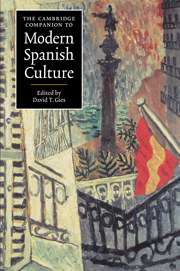Book contents
- Frontmatter
- Modern Spanish culture
- I Culture
- II Culture and history
- 5 History, politics, and culture, 1875-1936
- 6 History, politics, and culture, 1936-1975
- 7 History, politics, and culture, 1975-1996
- III Culture and prose
- IV Culture and poetry
- V Culture and theater
- VI Culture and the arts
- VII Media
- Index
- Series List
7 - History, politics, and culture, 1975-1996
from II - Culture and history
Published online by Cambridge University Press: 28 May 2006
- Frontmatter
- Modern Spanish culture
- I Culture
- II Culture and history
- 5 History, politics, and culture, 1875-1936
- 6 History, politics, and culture, 1936-1975
- 7 History, politics, and culture, 1975-1996
- III Culture and prose
- IV Culture and poetry
- V Culture and theater
- VI Culture and the arts
- VII Media
- Index
- Series List
Summary
A few months after Franco's death, many observers feared “that Spain may well revert, in the not too distant future, to the pattern or the path it had entered in the thirties, a pattern of extreme and polarized pluralism,” an experiment in democracy which had been “chaotic and far too brief.” In general, these observers continued to see Spanish society as torn by conflict - in keeping with the myth of the two Spains - as well as prone to violence and the extermination of the adversary. Even though the level of political violence in Spain since 1875 had been significantly lower than in other European countries, the dramatic experience of the Civil War had contributed to this image of backwardness, lack of civic culture, extremism, passion and cruelty. “Spain for some time to come needs to live under an authoritarian regime,” wrote Gerald Brenan in 1950, when he perceived the belief that parliamentary democracy could be an alternative to Franco to be a “very dangerous illusion.” Twenty years after that, no one was sure how Spaniards would react to Franco's death and many feared that they might simply revert to old, violent habits.
- Type
- Chapter
- Information
- The Cambridge Companion to Modern Spanish Culture , pp. 104 - 120Publisher: Cambridge University PressPrint publication year: 1999
- 3
- Cited by



